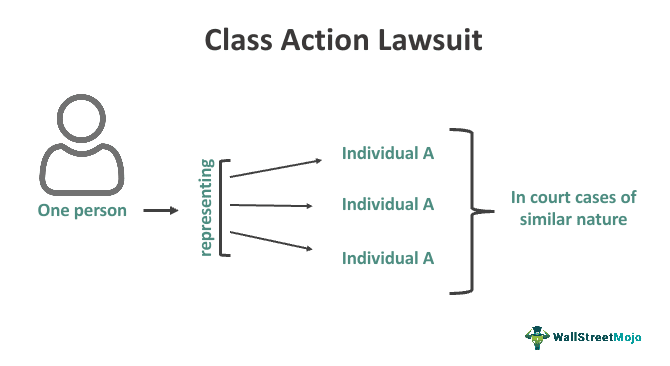Browsing Legal Waters: Recognizing the Ins and Outs of Class Action Lawsuits
Wiki Article
Comprehending Course Activity Claim: An Overview for Lawyers
Course activity lawsuits have come to be an integral part of the legal landscape, allowing for the loan consolidation of numerous insurance claims right into a single action. By diving right into the details of course action suits, this overview equips lawyers with the knowledge and tools required to effectively browse this complicated location of regulation.The Essentials of Course Action Legal Actions
Course activity claims are a lawful mechanism employed to settle comparable insurance claims from a team of individuals right into a single legal action, supplying a cost-effective and effective approach to seeking justice and resolution. This sort of legal action permits a depictive complainant, acting upon part of the entire course, to bring a claim versus an offender that has presumably created injury or violated the civil liberties of multiple individuals.The standard needs for bringing a class activity legal action include numerosity, commonality, typicality, and competence of depiction. Numerosity describes the truth that the course need to be so big that joinder of all participants would be unwise. Commonality implies that there should prevail concerns of legislation or reality that are shared by all participants of the class. Typicality requires that the insurance claims of the depictive plaintiff are typical of the cases of the entire class. Adequacy of depiction makes certain that the representative complainant will properly stand for the interests of the entire course.
Class activity claims can be helpful for both complainants and accuseds. For complainants, it permits them to merge their sources and share the dangers and prices related to lawsuits. It additionally gives a level having fun field when they are up against huge companies or entities. For offenders, it offers the opportunity to efficiently settle several claims in a solitary suit, avoiding the demand to prevent many individual legal actions.
Identifying and Assessing Possible Class Members
After establishing the standard requirements for a course activity lawsuit, the next action is to recognize and examine potential course members. This procedure entails identifying that may be component of the class and examining their insurance claims to determine if they fulfill the required standards.To determine prospective course members, legal representatives normally carry out considerable research and collect appropriate information. This may entail examining records, carrying out meetings, and examining documents to determine people or entities that might have been impacted by the claimed wrongdoing. It is important to establish a clear and extensive listing of potential class participants to make sure that all influenced parties are included in the lawsuit.
When possible class participants have actually been identified, the next action is to examine their insurance claims. This involves reviewing the benefits of each individual claim to figure out if they satisfy the legal needs for course certification. Legal representatives must carefully analyze the facts, evidence, and lawful concepts of each potential course member's case to guarantee that they have a feasible case.
Evaluating potential class participants also includes figuring out whether they satisfy the course meaning and have actually suffered comparable damage as an outcome of the offender's activities. This calls for contrasting the truths and conditions of each prospective course member's situation to the allegations and legal theories placed forth in the claim.
Navigating the Course Certification Refine
To successfully navigate the class certification procedure, attorneys have to carefully comply with the procedural requirements stated by the court. Class certification is a vital action in a course action suit, as it identifies whether a situation can continue as a course action, standing for a team of people that have similar claims versus an accused. The procedure entails pleasing certain criteria, such as numerosity, commonness, typicality, and competence of depiction.Firstly, lawyers have to establish numerosity by demonstrating that the course is so big that individual joinder is impractical. This can be attained with proof or expert testimony. Secondly, they need to establish commonness by revealing that there prevail concerns of legislation or reality that predominate over specific concerns. This requires a detailed analysis of the defenses and claims involved.
Following, legal representatives need to reveal typicality, which suggests that the depictive plaintiff's insurance claims are common of the claims of the class members. This ensures that the passions of the representative complainant align with the rate of interests of the class. Attorneys need to show competence of depiction, implying that the representative plaintiff and their advise will fairly and effectively stand for the passions of the course.
To navigate this procedure successfully, legal representatives should thoroughly prepare by conducting extensive study, gathering evidence, and creating a compelling disagreement that pleases each of these standards. They must additionally be prepared to react to any type of obstacles or objections elevated by the defendant. By diligently adhering to the step-by-step needs set forth by the court, lawyers can raise their opportunities of acquiring course qualification and progressing the rate of interests of the course members.

Key Methods for Taking Care Of Class Action Lawsuits
Upon successfully navigating the course qualification procedure, attorneys should then execute crucial techniques for efficiently taking care of course activity litigation. These strategies are critical to ensure that the situation continues smoothly and effectively, eventually making best use of the possibilities of a beneficial end result for the class participants.
One secret technique is to establish a natural and solid legal group (Class action lawsuit). This includes setting up a team of attorneys with expertise in course action litigation, along with various other relevant locations such as the details industry or subject involved in the case. A versatile group can bring different perspectives and abilities to the table, enhancing the general performance of the litigation
An additional crucial approach is to create a thorough and well-thought-out litigation plan. This plan needs to lay out the total purposes of the instance, along with the particular lawful concepts and disagreements that will be gone after. It needs to additionally consist of a timeline and spending plan to guarantee that the situation remains on track and within the assigned resources.
Furthermore, lawyers need to actively involve with the course members throughout the litigation procedure (Class action lawsuit). This consists of offering regular updates on the progression of the instance, seeking input and feedback from the course members, and attending to any worries or questions they may have. By cultivating open communication and collaboration, lawyers can construct trust fund and assistance among the course participants, which can be crucial in achieving an effective resolution
Settling Course Action Claims: Settlement and Authorization
When it involves working out class action claims, reliable arrangement and obtaining approval are crucial actions in accomplishing a resolution. Course action legal actions are intricate and include a multitude of plaintiffs, making it vital to reach a settlement that is reasonable and satisfactory to all events involved.
Once a settlement agreement is reached, it should be approved by the court. The court's function in this procedure is to ensure that the settlement is reasonable, practical, and properly secures the interests of the course participants. The court will certainly consider aspects such as the nature of the insurance claims, the strength of the evidence, the potential recuperation for the class participants, and any type of objections elevated by course participants.
Obtaining court authorization is vital as it provides finality to the negotiation and safeguards the rate of interests of the class members. It makes certain that the negotiation is binding and enforceable, and course members can receive their rightful payment.
Final Thought
Class action claims have actually become an indispensable part of the legal landscape, enabling for the debt consolidation of several claims right into a solitary activity. Class accreditation is an essential step in a class activity lawsuit, as it determines whether an instance can continue as a class action, representing a group of individuals that have comparable insurance claims versus a defendant. By carefully adhering to the procedural demands set forth by the court, legal representatives can boost their possibilities of acquiring class certification and progressing the interests of the class participants.
The court will think about aspects such as the nature of the claims, the strength of the evidence, the possible healing for the class members, and any type of objections raised by course participants.
By identifying and analyzing potential class participants, lawyers can establish the stability of a class activity claim.
Report this wiki page